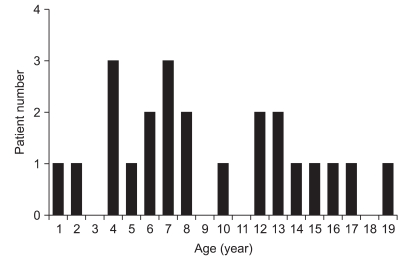Motor Evoked Potentials of the Upper Extremities in Healthy Children
- Affiliations
-
- 1Department of Physical Medicine and Rehabilitation, Institute for Medical Sciences, Chonbuk National University Medical School, Research Institute of Clinical Medicine, Chonbuk National University Hospital, Jeonju 561-180, Korea. shpark0130@jbnu.ac.kr
- KMID: 2266800
- DOI: http://doi.org/10.5535/arm.2011.35.6.759
Abstract
OBJECTIVE
To evaluate and compare the organization of descending motor pathways to upper extremity muscles among healthy children. METHOD: The healthy children were 16 males and 7 females aged 1-19 years (average, 9 years), and eight healthy adults were enrolled as the control group. Transcranial magnetic stimulation was applied to bilateral motor cortices, and motor evoked potentials (MEPs) were recorded using surface electrodes from the first dorsal interossei (FDI), the biceps brachii (BIC), and the deltoid (DEL) muscles. The onset latency, central motor conduction time (CMCT), and amplitude were obtained during a relaxed state.
RESULTS
MEPs of FDI were obtained from subjects aged 13 months. The frequency of obtaining MEPs in proximal and distal muscles increased with age, although there was a less frequent incidence of obtaining MEPs in the proximal BIC and DEL muscles compared with those in the distal FDI muscle. MEP amplitudes increased with age, whereas latencies were relatively constant. CMCTs showed a similar pattern of maturation, and adult values were obtained by 13-years-of-age.
CONCLUSION
These results suggest that the proximal and distal muscles of the upper extremities show different maturation and organization patterns.
MeSH Terms
Figure
Cited by 3 articles
-
Motor Evoked Potentials in the Upper Extremities of Children with Spastic Hemiplegic Cerebral Palsy
Da-Sol Kim, Eu-Deum Kim, Gi-Wook Kim, Yu Hui Won, Myoung-Hwan Ko, Jeon-Hwan Seo, Sung-Hee Park
Brain Neurorehabil. 2019;12(2):. doi: 10.12786/bn.2019.12.e10.Neuroradiological and Neurophysiological Characteristics of Patients With Dyskinetic Cerebral Palsy
Byung-Hyun Park, Sung-Hee Park, Jeong-Hwan Seo, Myoung-Hwan Ko, Gyung-Ho Chung
Ann Rehabil Med. 2014;38(2):189-199. doi: 10.5535/arm.2014.38.2.189.Ten-Year Follow-Up of Transcranial Magnetic Stimulation Study in a Patient With Congenital Mirror Movements: A Case Report
Eu-Deum Kim, Gi-Wook Kim, Yu Hui Won, Myoung-Hwan Ko, Jeong-Hwan Seo, Sung-Hee Park
Ann Rehabil Med. 2019;43(4):524-529. doi: 10.5535/arm.2019.43.4.524.
Reference
-
1. Dominkus M, Grisold W, Jelinek V. Transcranial electrical motor evoked potentials as a prognostic indicator for motor recovery in stroke patients. J Neurol Neurosurg Psychiatry. 1990; 53:745–748. PMID: 2174076.
Article2. Sohn YH, Hallett M. Motor evoked potentials. Phys Med Rehabil Clin N Am. 2004; 15:117–131. PMID: 15029902.
Article3. Garvey MA, Mall V. Transcranial magnetic stimulation in children. Clin Neurophysiol. 2008; 119:973–984. PMID: 18221913.
Article4. Lin KL, Pascual-Leone A. Transcranial magnetic stimulation and its applications in children. Chang Gung Med J. 2002; 25:424–436. PMID: 12350028.5. Nezu A, Kimura S, Uehara S, Kobayashi T, Tanaka M, Saito K. Magnetic stimulation of motor cortex in children: maturity of corticospinal pathway and problem of clinical application. Brain Dev. 1997; 19:176–180. PMID: 9134188.6. Nezu A, Kimura S, Takeshita S. Topographical differences in the developmental profile of central motor conduction time. Clin Neurophysiol. 1999; 110:1646–1649. PMID: 10479033.
Article7. Curra A, Modugno N, Inghilleri M, Manfredi M, Hallett M, Berardelli A. Transcranial magnetic stimulation techniques in clinical investigation. Neurology. 2002; 59:1851–1859. PMID: 12503582.
Article8. Agnew WF, McCreery DB. Considerations for safety in the use of extracranial stimulation for motor evoked potentials. Neurosurgery. 1987; 20:143–147. PMID: 3808255.
Article9. Sgro JA, Ghatak NR, Stanton PC, Emerson RG, Blair R. Repetitive high magnetic field stimulation: the eff ect upon rat brain. Electroencephalogr Clin Neurophysiol Suppl. 1991; 43:180–185. PMID: 1773756.10. Counter SA. Neurobiological effects of extensive transcranial electromagnetic stimulation in an animal model. Electroencephalogr Clin Neurophysiol. 1993; 89:341–348. PMID: 7691574.
Article11. Gilbert DL, Garvey MA, Bansal AS, Lipps T, Zhang J, Wasermann EM. Should transcranial magnetic stimulation research in children be considered minimal risk? Clin Neurophysiol. 2004; 115:1730–1739. PMID: 15261851.
Article12. Kirton A, Deveber G, Gunraj C, Chen R. Neurocardiogenic syncope complicating pedriatric transcranial magnetic stimulation. Pediatr Neurol. 2008; 39:196–197. PMID: 18725065.13. Müller K, Kass-Iilyya F, Reitz M. Ontogeny of ipsilateral corticospinal projections: a developmental study with transcranial magnetic stimulation. Ann Neurol. 1997; 42:705–711. PMID: 9392569.
Article14. Koh TH, Eyre JA. Maturation of cotricospinal tracts assessed by electromagnetic stimulation of the motor cortex. Arch Dis Child. 1988; 63:1347–1352. PMID: 3202641.15. Wassermann EM. Risk and safety of repetitive transcranial magnetic stimulation: report and suggested guidelines from the International Workshop on the Safety of Repetitive Transcranial Magnetic Stimulation, June 5-7, 1996. Electroencephalogr Clin Neurophysiol. 1998; 108:1–16. PMID: 9474057.
Article16. Roick H, von Giessen HJ, Benecke R. On the origin of the postexcitatory inhibition seen after transcranial magnetic brain stimulation in awake human subjects. Exp Brain Res. 1993; 94:489–498. PMID: 8359263.
Article17. Cantello R, Gianelli M, Civardi C, Mutani R. Magnetic brain stimulation. the silent period after motor evoked potential. Neurology. 1992; 42:1951–1959. PMID: 1407578.18. Garvey MA, Ziemann U, Bartko JJ, Denckla MB, Barker CA, Wassermann EM. Cortical correlates of neuromotor development in healthy children. Clin Neurophysiol. 2003; 114:1662–1670. PMID: 12948795.
Article19. Müller K, Hömberg V, Lenard HG. Magnetic stimulation of motor cortex and nerve roots in children. Maturation of cortico-motoneuronal projections. Electroencephalogr Clin Neurophysiol. 1991; 81:63–70. PMID: 1705221.
Article20. Rothwell JC, Thompson PD, Day BL, Dick JP, Kachi T, Cowan JM, Marsden CD. Motor cortex stimulation in intact man. 1. General characteristics of EMG responses in different muscles. Brain. 1987; 110:1173–1190. PMID: 3676697.
- Full Text Links
- Actions
-
Cited
- CITED
-
- Close
- Share
- Similar articles
-
- Motor Evoked Potentials and Somatosensory Evoked Potentials of Upper and Lower Extremities for Prediction of Functional Recovery in Stroke
- Changes of motor evoked potentials and spinal cord evoked potentials following spinal cord injury in rats
- Motor Evoked Potentials of Upper and Lower Extremities by Magnetic Stimulation in Hemiparesis
- Ten-Year Follow-Up of Transcranial Magnetic Stimulation Study in a Patient With Congenital Mirror Movements: A Case Report
- Motor Evoked Potentials in Masseter, and Anterior Belly of Digastric Induced by Transcranial Magnetic Stimulation


